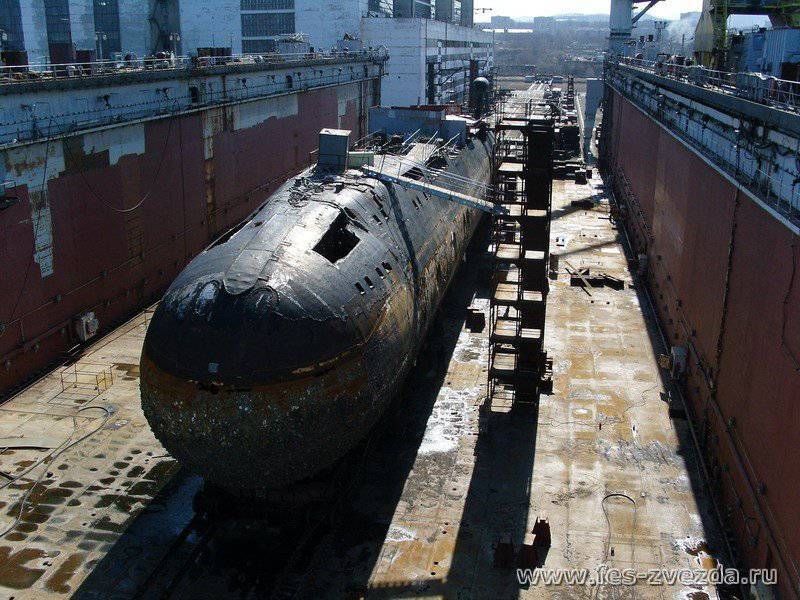The problem of disposing of atomic submarines

Five countries are armed with nuclear submarines (APL). It is believed that the life of the submarine is about 25 years. In Soviet times, the naval forces received 250 submarines. After the collapse of the Soviet bloc, most of them were withdrawn from the Navy. Before the Russian military was the task of their disposal.
To understand the level of this problem, you should list the stages of decommissioning submarines:
- it is necessary to drain the coolant and unload nuclear fuel from the reactor;
- cut, in the conditions of a stationary dock, the reactor compartment (the shelf life of the dismantled reactor unit is from 70 to 100 years);
- dismantle the equipment of the submarine;
- make sealing compartments and cover with anti-corrosion material;
- tow the dismantled parts and equipment to the place of long-term storage.
This process is not only costly, but time consuming. For example, in the USA, nuclear fuel has been outloaded for about a year. In Russia, the existing nuclear fuel storage facilities are overcrowded and a large number of nuclear submarines have been waiting for their disposal for many years. Most of the submarines are disposed of in the Russian Federation at the Nerpa, Zvezda and Zvezdochka factories and Mayak. Submarines are delivered to the shipyards of these plants either by towing or on a floating dock.
For comparison: the cost of disposing of one submarine in Russia is (depending on its type) from $ 2 million to $ 12 million, and in the USA it is equal to $ 50 million.
The capacities of the Russian plants are not enough for the regeneration of nuclear fuel, and special transport containers and freight containers TK-VG-18 are also not enough. The Russian side has yet another difficult problem - the release of storage facilities (coastal and floating) is extremely slow, which significantly slows down the process of unloading nuclear fuel, and, consequently, the dismantling of nuclear submarines. Currently, more than 200 Russian nuclear submarines, most of which were built during the Soviet era, are awaiting recycling.
In order to solve the disposal problem, the state corporation Rosatom plans to export radioactive waste from the territory of Kamchatka during 2014-2015. Waste will be deactivated and finally buried. It should be noted that in the area of the city of Vilyuchinsk since the 60-ies is one of the largest naval bases, passing in the documents of NATO, codenamed "Wasp Nest". Not far from this base there is an equipped storage facility in which nuclear waste from submarines is stored, including parts of submarines, personal protective equipment and other materials subjected to radioactive contamination. The radiation situation in the area is constantly monitored. The monitoring results indicate that the danger of the spread of radioactive waste was not detected. However, it was decided to build over the existing storage of the building, in which, in accordance with the technology, radioactive waste will be packed in special containers and exported from the territory of Kamchatka. This process will last as long as this Far Eastern submarine base exists on the peninsula.
The planned Rosatom program to free Kamchatka from nuclear waste is only part of a large comprehensive program for the disposal of Russian nuclear submarines that have served their life. Before 70-s, the submarine was buried by flooding them in the ocean. But after signing an agreement to ban the deployment of radioactive objects in the seas, oceans and subsoil, Russian scientists and engineers were faced with the problem of finding ways to dismantle nuclear submarines. Technically, this process is very complicated. But, at present, it was possible to accelerate the course of disposal thanks to the large financial assistance from abroad.
For example, Japan financed $ 25 million in construction of a floating installation in Primor for cleaning nuclear waste from nuclear submarines undergoing disposal, and also paid for the dismantling of five Victor-3 submarines. Japan handed over to the Russian side the equipment (a sea tugboat, two gantry cranes and a floating dock) necessary to create a long-term storage facility for nuclear submarines to be disposed of in the Rogue Bay.
A long-term storage facility for nuclear waste with nuclear submarines has also been established on the Kola Peninsula. The cost of this project was more than $ 400 million. Now there are 54 power units with submarines in storage. It would be very difficult for Russia alone to cope with the dismantling of old types of submarines, which is why European countries and the United States took part in this project. The European Bank financed the creation of conditions for the storage of drained fuel from the submarine class "Alpha". France paid for the transportation of this fuel. The development of a special container was paid for by the American side. The Italians financed the construction of the vessel, which will carry out the export of fuel.
Rosatom's specialists believe that joint efforts will establish a system for the dismantling of nuclear submarines. In the future, it is planned to clear the bottom of the Arctic Ocean from previously submerged submarine compartments and containers with radioactive substances.
Materials used:
http://expert.ru/2012/09/6/generalnaya-uborka/?n=66995
http://www.atominfo.ru/newsb/k0923.htm
http://www.militaryparitet.com/ttp/data/ic_ttp/1384/
Information